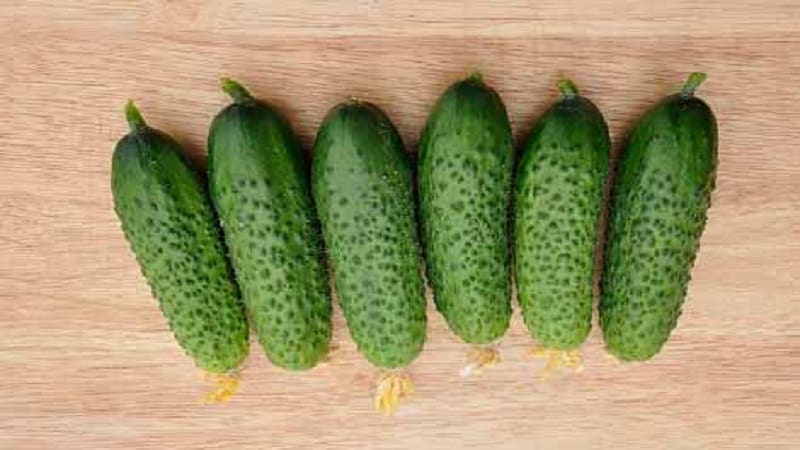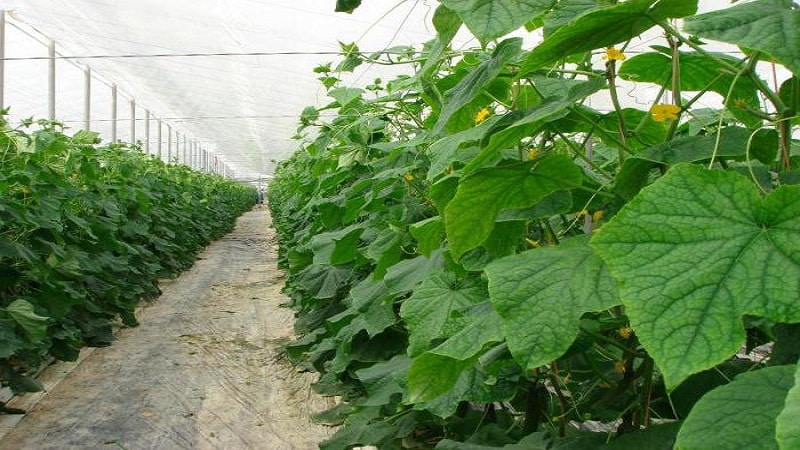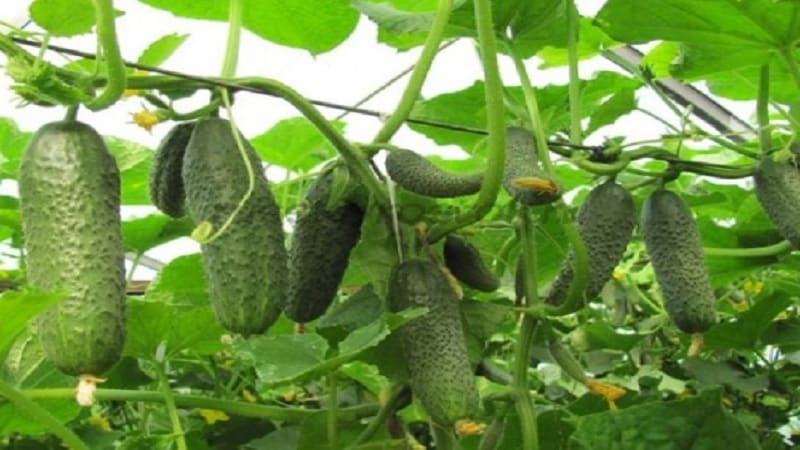A promising and high-yielding hybrid of cucumbers "Kibria", easy to care for and pleasant to taste
The parthenocarpic hybrid Kibria f1 is a high-yielding crop for all-season cultivation. High productivity, shelf life and transportability make it possible to cultivate cucumbers on an industrial scale. The crop is suitable for growing in a vegetable garden on a trellis, for which it has received high praise from amateur gardeners.
In the article we will understand the nuances of hybrid agricultural technology in open and closed ground, talk about methods of protecting plants from root rot and insect pests, and share reviews from summer residents.
Description of the hybrid
Hybrid Kibria f1 is a product of the Dutch company Rijk Zwaan, introduced in 2009. Included in the State Register of Russia in 2011. Received permission to grow in the North-West and Central regions in winter-spring and spring-summer rotations.
An indeterminate plant with a parthenocarpic type of pollination, suitable for cultivation in closed and open ground. The bushes are highly branched. Each node produces 1-3 female flowers.
In the photo - Kibria cucumber.

Characteristics
Distinctive features are presented in the table.
| Indicators | Characteristic |
| Ripening period | 49-57 days from emergence |
| Pollination type | Parthenocarpic |
| Weight | 70-90 g |
| Length | 10-11 cm |
| Form | Oval |
| Coloring | Dark green with short light stripes |
| Leaves | Medium size, green color |
| Pulp | Dense, juicy, without voids |
| Taste | Refreshing, no bitterness |
| Skin | Medium density, with small tubercles and white edges |
| Purpose | Universal |
| Productivity | 13.6-19.3 kg/m² |
| Sustainability | To cladosporiosis, powdery mildew, cucumber mosaic virus |
| Transportability | High |
Composition and calorie content
Nutritional value of cucumbers (per 100 g):
- proteins – 0.8 g;
- fats – 0.1 g;
- carbohydrates – 2.5 g;
- water – 95 g;
- fiber – 1 g;
- calorie content – 14 kcal.
Cucumbers are rich in vitamins: A, B1, B2, B4, B5, B6, B9, C, E, H, K, PP.
The fruits contain minerals:
- calcium;
- silicon;
- potassium;
- sodium;
- magnesium;
- sulfur;
- phosphorus;
- chlorine;
- iodine;
- iron;
- manganese;
- selenium;
- copper;
- chromium;
- fluorine;
- zinc.
Benefit
The amino acids and mineral components contained in cucumbers have a number of beneficial properties:
- remove salts;
- speed up metabolism;
- bind and remove free radicals;
- dilate blood vessels;
- normalize blood pressure;
- cleanse the blood of cholesterol plaques;
- dissolve sand and kidney stones;
- stimulate insulin production.
Agricultural technology for cucumbers
According to the manufacturer's recommendations, the Kibria hybrid cucumber is grown through seedlings. This is the only way to achieve complete survival of the plant in a new location.
Agricultural technology involves watering, feeding, loosening, weeding, protection from pests, fungi and bacteria, formation of bushes.
Planting by seedling method
When growing cucumber seedlings, consider the following points:
- Seed material is processed in production, therefore does not require the procedure of disinfection and soaking in germination stimulants.
- For sowing, special cassettes are best suited to minimize stress when transplanting seedlings into the ground.
- Before sowing, the soil is checked for acidity with litmus papers. Optimal pH = 6.If necessary, lime, chalk or dolomite flour is added to the soil to normalize the indicator.
- The soil mixture for seedlings is prepared from peat, humus and sawdust (in a ratio of 2:2:1), with the addition of perlite. For disinfection, use “Fitosporin” or a strong solution of potassium permanganate. Heating in the oven at a temperature of 110°C kills pathogenic microflora no less effectively.
- The cassettes are filled with moist soil and the seeds are planted to a depth of 1 cm.
- Seedlings for heated greenhouses begin to grow in the last ten days of December. In January, after the first leaves appear, the seedlings are transferred to a permanent place.
- In greenhouses without heating, planting is carried out in the last ten days of April or in the first ten days of May.
- For cultivation in open ground, in spring-summer rotation, the seeds are sown in mid-April. Transplantation is carried out in May.
- Before being transferred to the soil, the seedlings are fed twice with ready-made mineral complexes “Breadwinner” or “Fertility”. Dissolve 1 tbsp in 10 liters of warm water. l. drug. Consumption per seedling – 100 ml.
Growing and care

Seedlings are planted in the ground at the stage of 4-5 leaves. Soil temperature – not lower than +18 °C.
High beds are formed on the site for air ventilation. There are two bushes per 1 m². Planting pattern – 70x60 cm.
The holes are formed at a depth of 5 cm, filled with boiling water and the seedlings are transferred along with a lump of earth.
Reference. Usually, 45 days pass from the moment of planting cucumber seedlings to the appearance of the first fruits.
Rules of care:
- The first time after planting, cucumbers are provided with abundant watering, then they switch to drip watering.
- After watering from a watering can, the soil is loosened to prevent the formation of a hard crust.
- Weeding and removal of weeds is carried out regularly.To reduce the frequency of weeding, the soil is mulched with sawdust, hay, peat or agrofibre.
- For fertilizing, products containing potassium, phosphorus, calcium, magnesium and a small amount of nitrogen are used. The best organic fertilizers to use are cow manure or chicken manure.
Options for organic fertilizers for the first feeding of cucumbers:
- dilute cow manure with water in a ratio of 1:8;
- Dilute chicken manure with water – 1:15.
Mineral compositions for the second and third feeding (per 10 liters of water):
- 30 g ammonium nitrate, 40 g superphosphate, 20 g potassium nitrate;
- 40 g superphosphate;
- 10 g of potassium magnesia, 40 g of superphosphate extract (pour boiling water and leave for a day);
- ¼ tsp. boric acid and potassium permanganate on the tip of a knife - for foliar treatment (stimulates flowering);
- 50 g urea;
- 2 tbsp. l. potassium nitrate.
To extend the life of the vines, gardeners advise carrying out a fourth, optional feeding: pour rotted hay with water 1:1 and leave for 48 hours. Process the cucumbers three times every seven days.
Features of cultivation and difficulties
The hybrid reacts painfully to elevated air temperatures in the greenhouse. Therefore, to create a comfortable microclimate, ventilation is arranged.
Kibria cucumbers tend to overgrow, so harvesting is done daily. This helps the plant form new ovaries. Otherwise, productivity decreases.
Fruiting in the hybrid is focused on the main stem. In this regard, it is recommended to form bushes of non-standard shape:
- Initially, the first 4-7 axils on the main stem are blinded.
- Then the side shoots and ovaries are removed (if there are more than three of them in one node) right up to the trellis. The height of the bush should be 2.7 m.
- The main stem is thrown over the trellis and lowered down. After 4-5 sheets, pinching is done.
1-2 shoots of the first order remain on the trellis. This molding provides access to light and the fruits ripen faster. The technique is used when there is a lack of sunlight.
Reference. Blinding of cucumbers - removal of leaves, tendrils, shoots from the axils in order to increase productivity, improve disease resistance, and prolong fruiting.
Diseases and pests
The hybrid is immune to cladosporiosis, powdery mildew, and cucumber mosaic virus. Root rots are dangerous: pythium, rhizoctonia and fusarium.
Signs of pythium:
- watery, slippery, dark spots on the leaves;
- leaves shrink and change color to dark brown;
- destroyed tissues of the root collar and main root.
Preventive treatment of seeds and seedlings with biological preparations (Gamair, Planriz, Baktofit, Trichodermin) will prevent infection. The products contain antagonistic fungi that limit the accumulation of rot pathogens in the soil. Treatment of cucumbers with chemicals during the period of active growth, unfortunately, is difficult due to the early ripeness of the hybrid.
Signs of rhizoctoniasis:
- yellowing and drying of the root collar;
- oval spots on cotyledons, yellow and yellow-orange;
- sores on petioles;
- brown spots on leaves;
- oval dark brown spots on the fruit with an orange border.
When cultivating cucumbers in greenhouses, it is recommended to maintain temperature and humidity conditions. In the garden, drip irrigation is used, agrofibre is used to mulch the soil, and timely weeding and fertilizing with mineral compounds are carried out.
To combat the fungus, biological agents are used: “Pseudobacterin-2”, “Trichodermin”.
Signs of fusarium:
- change in the cut of stem vessels from green to brown;
- rotting of the stem from the roots;
- yellowing and wilting of leaves.
It is easier to prevent a disease than to fight it. For prevention, do the following:
- Before planting seedlings, the soil is spilled with boiling water or a concentrated solution of potassium permanganate;
- sow phacelia or mustard in the beds;
- monitor the humidity level;
- follow watering rules;
- infected bushes are immediately removed by the roots.
Biological products are used for treatment: Trichodermin, Planriz, Baktofit.
The main pests of cucumbers are melon aphids, spider mites, mole crickets, cucumber gnats, tobacco thrips, and slugs.
To quickly and effectively get rid of insects, insecticides are used: “Fitoverm”, “Aktofit”, “Commander”, “Karbofos”, “Nemabaktin”, “Medvetox”, “Grom”, “Aktara”.
Options for folk remedies and methods:
- To get rid of slugs the beds are sprinkled with tobacco dust, allspice, rosemary, and cans of beer are set as traps.
- Fight tobacco thrips Treating the bushes with an infusion of onion peels will help. Several handfuls of husks are poured with hot water and left for two days. Then the volume is adjusted to 10 liters. Treatment is carried out twice a month.
- In the fight against the cucumber mosquito Regular yellow adhesive tape is effective. Insects are attracted to bright colors.
- Destroy mole cricket can be done using a soap-powder solution. For 10 liters of water, take 2 pieces of laundry soap, ground into crumbs, and 1 tbsp. l. washing powder. The solution is poured into the burrows.
- Against spider mites use garlic infusion. Take three heads of chopped garlic per 2 liters of water and leave for 4-5 days. The concentrate is diluted with water 1:1. Spraying is carried out late in the evening.
- Get rid of aphids Hot pepper and tobacco dust will help. For 10 liters of water you will need 30 g of pepper, 200 g of tobacco. After 24 hours, filter the infusion and add 20 g of liquid soap and 100 g of ash. For 1 m² – 3 liters of infusion.
Harvesting and application

Cucumbers of the Kibria f1 hybrid are harvested daily due to their tendency to overgrow. The optimal length of the fetus is 10-11 cm.
The fruits are characterized by excellent taste without bitterness. Dense, crispy cucumbers without voids are suitable for fresh consumption, pickling And pickling for the winter.
Shelf life in a cool place after collection is two weeks.
Advantages and disadvantages
Advantages of a hybrid:
- ease of care;
- rapid recovery from stress (sharp cold snap, low humidity);
- resistance to viral diseases;
- excellent taste;
- keeping quality and ability to transport;
- lack of bitterness;
- versatility of use;
- early ripening;
- high productivity.
Flaws:
- predisposition to root rot;
- demands on lighting;
- high cost of seed material.
Reviews
The Kibria hybrid appeared on the domestic market relatively recently, but has already received positive reviews.
Vadim, Bryansk: «As a gardener with extensive experience in growing different varieties and hybrids of cucumber, I can confidently recommend Kibria for cultivation to those who are encountering this matter for the first time. The culture is unpretentious in care and requires only moderate watering and timely fertilizing. With the right agricultural technology, there is practically no illness.”
Olga, Kaluga: “I grow cucumbers in large quantities for sale. In the greenhouse I plant mainly Dutch hybrids. Kibria is liked for its ease of care and high productivity.An important nuance of agricultural technology is a minimum of nitrogen, a maximum of minerals when feeding. The crop loves light, so at the seedling stage it needs additional lighting.”
Conclusion
Cucumber Kibria f1 is a promising, high-yielding hybrid with excellent taste without bitterness, which is popular among consumers and farmers. The culture does not require a special approach to cultivation and bears fruit even under stressful conditions.
The main conditions for successful cultivation are shaping the bushes by blinding the sinuses, maintaining optimal temperature and air humidity. The hybrid is resistant to viruses, but suffers from fungi that cause root rot. The success of the fight against the disease depends on compliance with the rules of agricultural technology and preventive treatments with biological products.